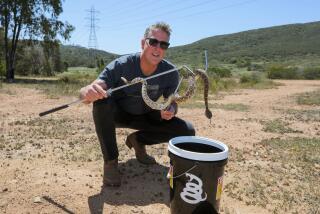At One With the Snails
- Share via
PROTEM, Mo. — More than 170 feet below the surface, Tom Aley feels his way through a pitch-black cave, searching for a blind snail no bigger than a grain of sand.
The air is dank and cold. Aley squeezes his 6-foot-3, 195-pound frame through a gap in the stone just wider than his thighs. Far ahead, he can hear the faint sound of water trickling through the cave, which stretches out for two miles. It’s the underground creek that winds through Tumbling Creek Cave, buried deep in the lush rolling hills of southwest Missouri.
Along the creek, inside this cave he owns, Aley discovered what has become his obsession: the snail called Antrobia culveri.
There is nothing else like it -- it is the only species in its genus and so far, it has been seen only in this cave.
About 15,000 Antrobia culveri once flourished here. Today, fewer than 150 are left: Runoff from overgrazed pastures has washed sediment and pollution into the creek’s once icy clear waters, and is thought to have killed off nearly all the snails.
Aley’s attempts to keep this seemingly insignificant creature alive destroyed his first marriage, cost him $1.4 million and consumed 38 years of his life. The dwindling snail population exasperates him -- he sees it as a personal failure -- but Aley refuses to stop.
Over the years, Aley tried to convince locals that the creature with no eyes and no mouth was worth saving. He convinced scientists to dissect its delicate yellow shell, scrutinize its gills through a microscope and spend hours in the stream tracking how it moved. Aley spent nights in the cave, hoping to figure out how the snail breeds, what it eats, and why it exists. Many things about the snail, however, remain unknown.
“People ask, ‘Aren’t you going off the deep end?’ But this snail is my life,” said Aley, 66. “I see it as a piece of our ecosystem. If you start losing pieces of the system, it’s all at risk. What happens to the snail could happen to us.”
Aley didn’t know the snail existed when he bought the cave in 1966. Back then, he dreamed of earning a living by turning the underground space into a high-priced laboratory for scientists.
Now, he’s broke. And most of the locals just think he’s crazy. They don’t seem to care that the snail was designated an endangered species in 2002, or that the cave is a national landmark because it has the most diverse fauna of any cave west of the Mississippi.
“Tom’s not raising cattle and he’s not renting out his land as pasture, so people around here think what he’s doing is a waste of time,” said Dick Myers, a neighbor and a retired zoology professor from the University of Missouri, Kansas City.
They don’t understand Aley’s motives and don’t trust him -- they still consider him an outsider, said Myers, 73.
Aley grew up in Wintersville, Ohio, surrounded by forests. From his front porch at the top of a hill, he recalled, he could see into West Virginia and Pennsylvania and spot only one building -- a barn.
He feels most at home in dark, rocky spots. Aley first climbed into a cave in 1956, as a freshman studying forestry at UC Berkeley. Hikes led to overnight stays underground.
After graduation, he joined an environmental consulting firm in Orange County, where a job as a hydrologist let him indulge his fascination. He surveyed caves in the Dominican Republic and Cuba for the military, and studied underground rivers in New Mexico and California for medical research.
At 27, Aley quit his job to turn a cave into a lab.
“At the time, there were only three underground laboratories in the world: China, Romania and France,” said Aley, who hoped U.S. scientists would pay to work in his lab. “Scientists could do experiments that depended on specific environments, such as absolute darkness.”
Taking their savings, Aley and his first wife Phyllis drove across the country in 1966, looking for the ideal space: big enough to offer a diverse collection of animals and plants, rural enough to avoid city pollution. For nine months, Aley pulled into small towns, walked into grocery stores and looked up real estate agents in phone books. He sent them postcards asking the same thing: Do you have a cave for sale?
In Missouri, known as the land of 5,000 caves, one agent said yes.
Aley drove to Protem, a rural community about 38 miles southeast of Branson, Mo. He slipped into his dirtiest jeans, got down on his hands and knees, and crawled into Tumbling Creek Cave.
There, surrounded by creatures he had never seen before, Aley fell in love. He spent the remaining savings -- $3,500 -- and bought 126-acres and the 70% of the cave that was below the acreage.
“I took a job with the U.S. Forest Service as a hydrologist to pay for food and supplies,” Aley said. “All I could think about, though, was the cave.”
Its natural entrance wasn’t for sale, but the owners allowed Aley access to map the cave. Then he began to dig. On weekends, he drilled and blasted his way inside. After building steps down to a small cavern, Aley carved a 2,100-foot trail that led to the creek and a bounty of life.
He saw furry gray bats, each the size of an infant’s hand, next to white millipedes as thin as thread. Tiny gray spiders and grotto salamanders hid inside crevices, while cave webworms spun sticky webs. Aley found more than 100 types of animals. There were several new species, including the snails.
They were discovered when a visitor handed Aley a rock. Aley noticed it was covered with tiny white dots that, when examined, were miniature shells. Puzzled, he gathered some of the organisms and sent them off to a taxonomist. But the taxonomist told Aley the snails didn’t fit into any established genera.
Environmental experts, curious about the creature, came out at Aley’s invitation to study it. They, too, were baffled. Sure, it was a snail: When the snail was magnified, they could see the three whorls of its shell. But what kind?
Aley then mailed some snails to naturalist Leslie Hubricht. Hubricht determined the snail was unique and published his findings in a biology journal, the Nautilus, in 1971.
“After that, it was official. The snail was special,” Aley said. “I felt responsible for them. This was their home, and I owned it. It was my job to take care of them.”
But by then, Aley had realized that his plan to run a money-making laboratory was failing. Federal funds for research were drying up, and few people wanted to travel to a rural lab.
“I had created an opportunity for a market that didn’t exist,” Aley said. “The bills were growing. My wife was not amused.”
Aley said she was tired of his enthrallment with the underworld, and asked him to choose: her or the snails.
He refused to leave his cave. She left in 1973.
“She was inordinately supportive,” Aley said. “She said I could keep the cave and the snails.”
The same year, Aley left the Forest Service and became a consultant specializing in how water moves both above and below ground. The work routinely took him out of town, so he hired biologist and zoologist Cathy Keith to watch over the cave and handle tours for visitors and school groups.
When Aley returned, the pair would spend hours underground, making sure the different creatures were faring well. They married in 1975, and built a log cabin a short hike away.
“Everything was fine, until we started to notice that the snails were disappearing,” said Cathy, 55. “We couldn’t move them, because they wouldn’t survive. But if they stayed in the creek, they would die.”
The culprit, the Aleys theorized, came from the surface.
Water -- coming from the same aquifer that feeds into the wells used by locals -- drained into the cave from nine-square miles.
The Aleys owned some of that land. But much of the remaining property was used for cattle grazing. As vegetation on the land thinned, the soil became loose. Any time it rained, the water eventually slipped into the cave, carrying with it silt.
That silt, the Aleys decided, was an enemy to snail and human alike.
“It sure made a bunch of us nervous,” said Myers, the neighbor.
Tom Aley contacted U.S. Fish and Wildlife Service officials who said they needed proof that the snails were in trouble. In 1995, the agency agreed to fund a five-year program -- which has since been extended -- to monitor the snails’ health.
“They needed someone to go down there and conduct tedious, menial tests. They thought of me because that’s the sort of thing I like to do,” said David Ashley, a biology professor at Missouri Western State College.
Every three months, Ashley stepped into the creek, picked up rocks within a sample area and recorded each snail. At the beginning of the study, he estimated there were 1,200 snails in that part of the stream. By 2001, Ashley found one but knew there were dozens elsewhere in the creek.
The Aleys leveraged their consulting salaries and tapped their savings to begin buying land from neighbors, bit by bit. After years of pleading, one dairy farmer recently sold the scientists his land for close to $1 million.
Today, the Aleys own the entire cave, as well as 2,500 acres above it. Between their holdings and those of other “snail-friendly” people, Aley said, about 79% of the land that feeds water into the cave is protected.
With help from federal grants, the couple has planted 52,000 trees to revitalize the land and protect the snail’s habitat. They expect to plant another 20,000 this spring, and will help Ashley when he comes later this year to count the snails.
Nearly every dollar the couple earns goes to pay the land mortgage. They tried ecotourism to raise cash, but the idea of paying to crawl through a cave in hopes of catching a glimpse of a nearly invisible, translucent snail failed to catch on.
Aley can’t understand why. Inside the cave, he blissfully listens to the gurgling water and nimbly moves past stalagmites that archeologists have estimated were formed hundreds of thousands years ago. He steps into a chamber with a 60-foot-tall ceiling. At his feet is the creek.
Aley turns on a miner’s lamp and searches the ground. Gingerly kneeling at the water’s edge, he flashes the light onto a rock and carefully studies it. Nothing. He moves to another rock, then another. There is no sign of snail life here, though Aley knows a small cluster still lives upstream.
“I feel like such a failure,” Aley said. “We have been the caretakers of this snail and of this environment. If we had succeeded, the snail would never be an endangered species.”
More to Read
Sign up for Essential California
The most important California stories and recommendations in your inbox every morning.
You may occasionally receive promotional content from the Los Angeles Times.










